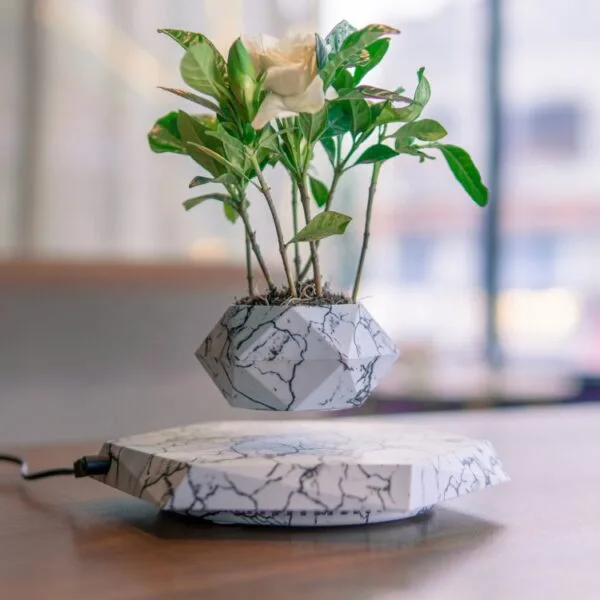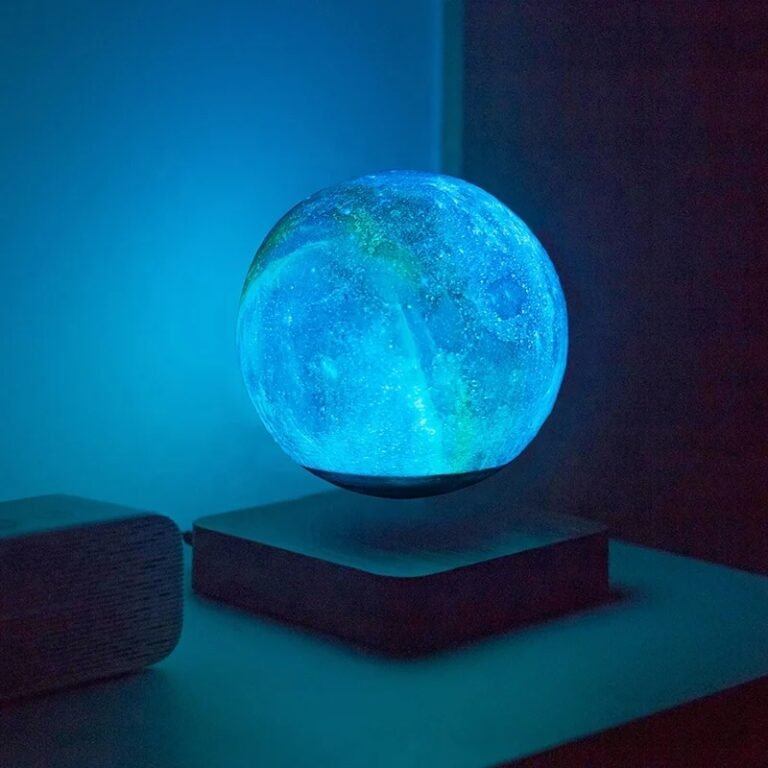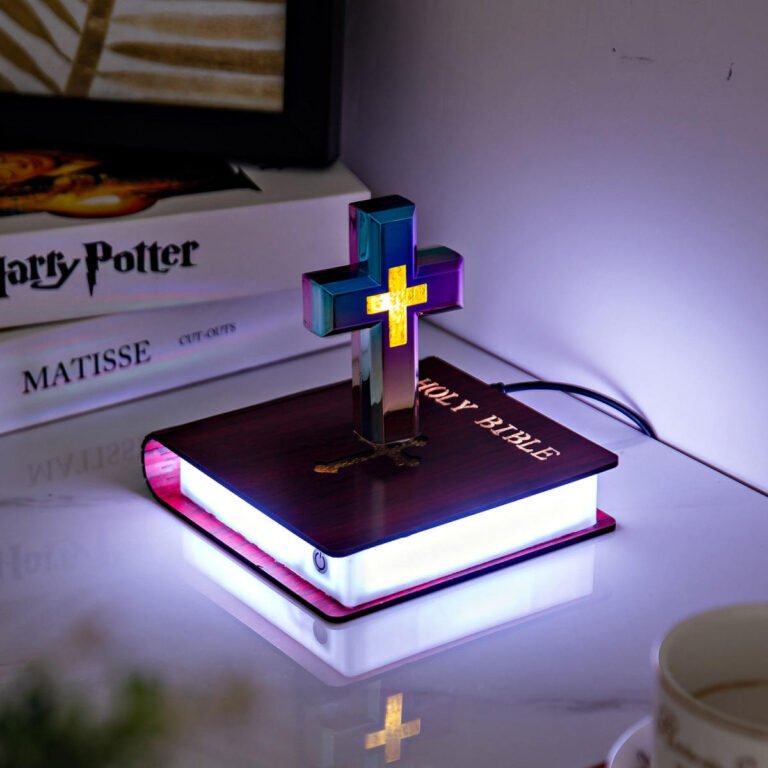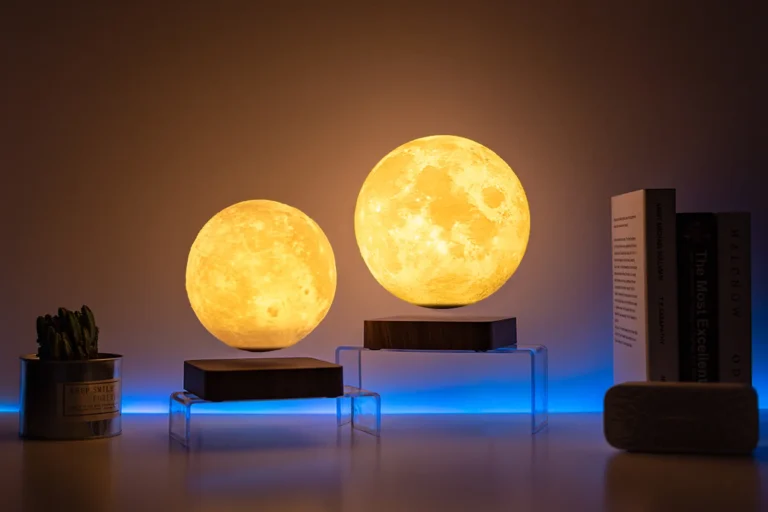So stellen Sie Schritt für Schritt Ihren eigenen schwebenden Blumentopf zu Hause her
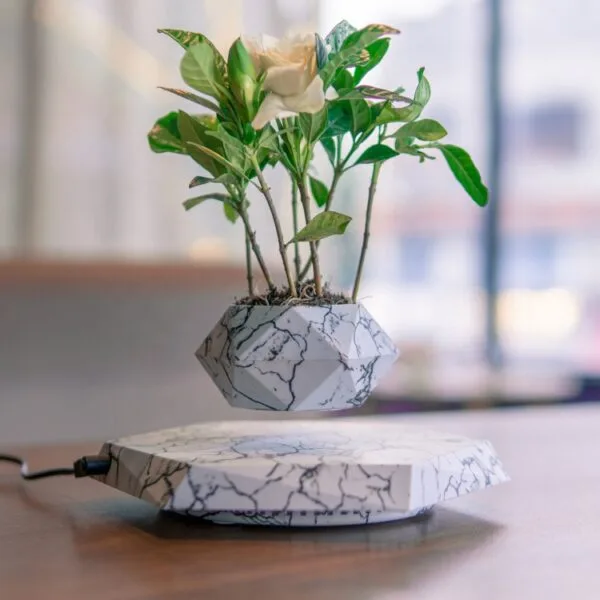
Sie können durchaus zu Hause einen schwebenden Blumentopf herstellen. Stellen Sie sich vor, Sie hätten eine Pflanze, die schwimmt und sich sanft dreht, Verwandeln Sie Ihr Zimmer in einen futuristischen Raum. Die Leute lieben diese Töpfe, weil sie fantastisch aussehen, Helfen Sie den Pflanzen, besser zu atmen, und sogar Wasser sparen. Du wirst deine Freunde begeistern, Verschönern Sie Ihre Einrichtung, und vielleicht sehen Sie sogar, wie Ihre Pflanze stärker wird. Bereit, etwas Magisches auszuprobieren? Du hast das!
Einzigartige und moderne Inneneinrichtung
Faszinierender Schwebeeffekt
Bessere Belüftung der Wurzeln
Tolle Geschenkidee
Gesprächsstarter
Key Takeaways
Bei der Magnetschwebebahn werden Magnete eingesetzt, um Ihren Blumentopf zum Schweben und Drehen zu bringen, eine coole und moderne Dekoration schaffen.
Wählen Sie leichte Pflanzen wie Luftpflanzen oder Sukkulenten, damit der Topf schwimmt, wie es die meisten Systeme aushalten 300 Gramm.
Sammeln Sie einfache Materialien wie eine elektromagnetische Basis, ein kleiner Pflanzer, und einen Scheibenmagneten, um Ihren schwebenden Topf zu Hause zu bauen.
Befolgen Sie sorgfältige Schritte, um den Topf zusammenzubauen und auszubalancieren, Halten Sie Metallgegenstände fern und üben Sie, den perfekten Schwimmplatz zu finden.
Gestalten Sie Ihren Topf individuell mit Farbe, Formen, oder 3D-Druck passend zu Ihrem Stil und genießen Sie gleichzeitig einfache Pflege und bessere Pflanzengesundheit.
Grundlagen zu schwebenden Blumentöpfen
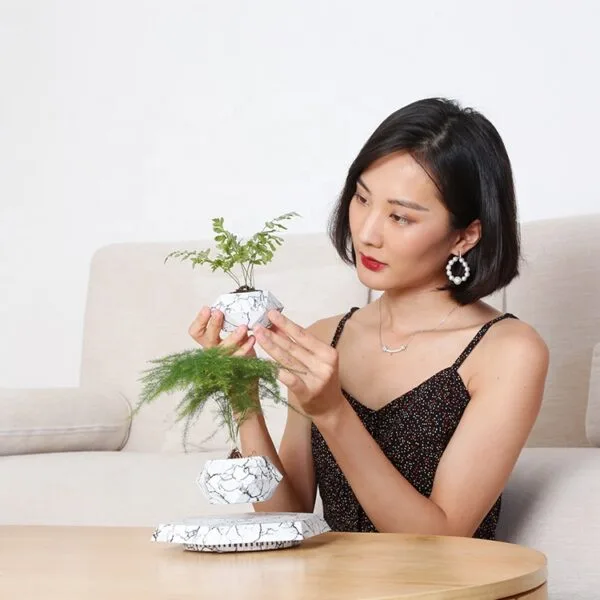
Magnetische Levitation
Haben Sie sich jemals gefragt, wie eine Pflanze in der Luft schweben kann?? Das Geheimnis ist die Magnetschwebebahn. Dieser coole wissenschaftliche Trick verwendet Magnete, um Dinge schweben zu lassen, ohne etwas zu berühren. In einem schwebenden Blumentopf, Sowohl der Sockel als auch der Topf verfügen über Magnete. Diese Magnete drücken gegeneinander, Dadurch wird der Topf angehoben und in der Schwebe gehalten.
Hier ist eine einfache Tabelle, die Ihnen zeigt, wie die Hauptteile zusammenarbeiten:
Komponente | Was es tut |
|---|---|
Erzeugt mithilfe von Spulen und elektronischer Steuerung ein starkes Magnetfeld | |
Blumentopfmagnet | Sitzt im Topf und reagiert auf das Magnetfeld der Basis |
Magnetische Kraft | Drückt sich gegen die Schwerkraft nach oben, um den Topf in der Luft zu halten |
Feedback-Kontrollsystem | Passt das Magnetfeld an, um den Topf stabil und im Gleichgewicht zu halten |
Überprüfen Sie die Position des Topfes und sorgen Sie dafür, dass er an der richtigen Stelle bleibt |
Tipp: Der Das Magnetfeld bildet eine Art unsichtbare Schale. Dadurch bleibt der Topf an Ort und Stelle und lässt ihn sogar langsam rotieren!
Wie es schwimmt
Der schwebende Blumentopf schwebt, weil die Magnetkraft des Bodens der Anziehungskraft der Schwerkraft auf den Topf entspricht. Wenn Sie den Topf über die Basis stellen, Die Magnete schieben sich voneinander weg. Wenn Sie die richtige Balance finden, der Topf schwebt in der Luft.
Aber hier ist etwas Wichtiges: Die Das Gewicht Ihrer Pflanze ist sehr wichtig. Das System funktioniert am besten mit leichten Pflanzen. Wenn Ihre Pflanze zu schwer ist, Die Magnete können es nicht halten, und der Topf wird fallen. Die meisten schwimmenden Töpfe sind nur für Pflanzen geeignet bis ca 300 Gramm. Also, Wählen Sie eine kleine Pflanze oder eine Sukkulente, um die besten Ergebnisse zu erzielen.
Notiz: Möglicherweise müssen Sie die Basis oder den Topf anpassen, um die perfekte Balance zu erreichen. Manchmal, Man muss es ein paar Mal versuchen, bis der Topf genau richtig schwimmt.
Materialien und Werkzeuge
Erforderliche Teile
Sie benötigen ein paar wichtige Dinge, um Ihre Pflanze zum Schwimmen zu bringen. Hier ist eine praktische Tabelle, die Ihnen hilft, den Überblick zu behalten:
Komponententyp | Artikel/Beschreibung |
|---|---|
Magnetschwebegerät | |
Pflanzgefäß/Container | Stahlbierdose (Magnetstöcke ohne Kleber) oder ein anderer Behälter (Kleber benötigt) |
Anlage | Kleine Pflanze, Wie eine Luftpflanze (Tillians) |
Werkzeuge | Bohrer mit einem Bit, Dosenöffner, Kleber (optional) |
Ich möchte eine schnelle Checkliste? Versuchen Sie diese Schritte:
Nehmen Sie eine Holzkiste und machen Sie ein Loch für das Netzkabel.
Schließen Sie das Netzkabel mit der Elektromagnet -Basis innerhalb der Box an.
Wählen Sie einen kleinen Behälter für Ihren Pflanzer.
Befestigen Sie den Disc -Magneten im Pflanzer mit Kleber.
Legen Sie den Pflanzer über den Boxdeckel, direkt zwischen den Magneten.
Fügen Sie Ihre Pflanze hinzu.
Bewegen Sie den Magneten und finden Sie den Sweet Spot for Levitation.
Stecker die Stromversorgung. Halten Sie Metallobjekte fern!
Tipp: Luftpflanzen funktionieren am besten, weil sie leicht sind und keinen Boden benötigen.
3D Druckoptionen
Wenn Sie Ihren eigenen Pflanzer entwerfen möchten, 3D Druck ist eine lustige Wahl. PLA ist das beliebteste Material für Pflanzgefäße im Innenbereich. Es ist einfach zu bedienen und erschwinglich. PETG und ABS sind besser, wenn Sie möchten, dass Ihr Topf draußen hält da sie Hitze und Sonnenlicht besser vertragen. Der Keramikdruck macht Töpfe besonders langlebig, aber es ist schwieriger zu finden.
PLA: Ideal für den Innenbereich, biologisch abbaubar, einfach zu drucken.
PETG: Stärker, hitzebeständiger, gut für Pflanzgefäße im Freien.
ABS: Robust und langlebig, Funktioniert gut draußen.
Keramik: Am besten für Haltbarkeit, aber nicht immer verfügbar.
Notiz: Wenn Sie PLA im Außenbereich verwenden, Versuchen Sie es mit einer UV-beständigen Beschichtung, damit es länger hält.
Beschaffung von Verbrauchsmaterialien
Magnetschwebemodule finden Sie online. Viele DIY-Kits stammen von Lieferanten aus China, wie Shenzhen Rongxingtong Electronics. Diese Kits kosten normalerweise zwischen $10 Und $15, und Sie können nur ein Set bestellen. Bei Ihrer ersten Bestellung ist der Versand oft kostenlos. Wenn Sie ein zuverlässiges Modul wünschen, Suchen Sie nach Marken wie Goodwelle oder Gleagle. Sie bieten stabiles Schweben und unterschiedliche Gewichtskapazitäten. Sie benötigen außerdem eine 12-V-Stromversorgung, Das ist in Elektrofachgeschäften leicht zu finden.
Für Trinkgeld: Der Kauf eines Bausatzes spart Zeit und erleichtert die Montage. Wenn Sie gerne Dinge von Grund auf neu bauen, Sie können einzelne Teile bestellen und Schritt-für-Schritt-Anleitungen online folgen.
Montageschritte
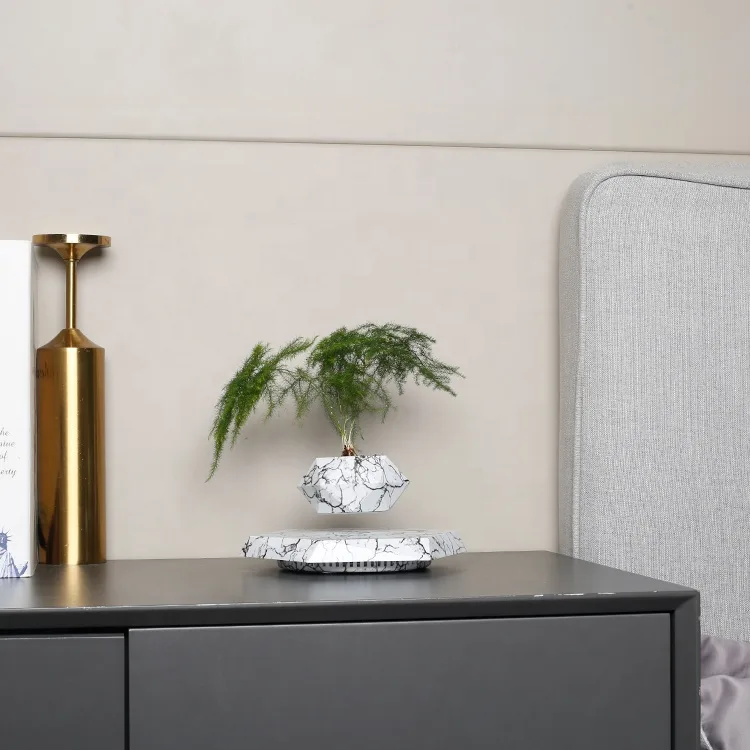
Basisvorbereitung
Beginnen Sie damit, Ihren Arbeitsplatz vorzubereiten. Wähle eine Wohnung, stabiler Tisch, der keine Metallteile darunter hat. Metall kann die Magnete beeinträchtigen und dazu führen, dass Ihr schwebender Blumentopf nicht mehr funktioniert. Platzieren Sie den Magnetfuß auf dem Tisch. Stellen Sie sicher, dass sich nichts Metallisches in der Nähe befindet, inklusive Werkzeug, Schmuck, oder sogar Ihr Telefon.
Jetzt, Verbinden Sie das Textilkabel vom Magnetfuß mit dem Netzteil. Stecken Sie den Adapter in eine Steckdose. Die meisten Magnetschwebemodule funktionieren am besten mit einem 12-V-Gleichstromadapter, der ca 2 Verstärker. Dadurch erhält Ihre Basis genügend Energie, um ein starkes Magnetfeld zu erzeugen.
Sicherheitstipp: Halten Sie Magnete von Kindern und Haustieren fern. Neodym-Magnete sind sehr stark und können Ihre Finger stark einklemmen. Sie können auch zerbrechen und scharfe Teile wegschleudern, Tragen Sie daher einen Augenschutz, wenn Sie direkt damit umgehen müssen.
Zusammenbau eines schwebenden Blumentopfs
Nächste, Bereiten Sie Ihr Pflanzgefäß vor. Wenn Sie eine Stahldose verwenden, Sie können den Magneten ohne Kleber hineinkleben. Für andere Behälter, Verwenden Sie einen starken Kleber, um den Scheibenmagneten im Boden des Topfes zu befestigen. Lassen Sie den Kleber vollständig trocknen, bevor Sie fortfahren.
Wählen Sie eine leichte Pflanze, wie eine Luftpflanze oder eine kleine Sukkulente. Legen Sie es in den Topf. Stellen Sie sicher, dass das Gesamtgewicht unter dem Grenzwert für Ihr schwebendes Blumentopfsystem bleibt – normalerweise etwa 300 Gramm.
Notiz: Verwenden Sie niemals durchnässte Erde oder schwere Pflanzen. Die Magnete können nur eine begrenzte Menge anheben!
Magnetausrichtung
Dieser Schritt erfordert etwas Geduld. Halten Sie Ihren Pflanzer herum 8 Zoll (20 cm) über der Mitte der Magnetbasis. Senken Sie es langsam gerade nach unten. Bewegen Sie sich langsam und halten Sie Ihre Hand ruhig. Wenn Sie spüren, dass der Topf nach hinten drückt oder wackelt, Sie haben das Magnetfeld gefunden.
Lassen Sie den Topf vorsichtig los. Wenn es schwimmt, Du hast es geschafft! Wenn es herunterfällt oder umkippt, versuchen Sie es erneut. Manchmal braucht man ein paar Versuche, um den Sweet Spot zu finden. Entfernen Sie alle Metallgegenstände von Ihren Händen, bevor Sie es versuchen. Sogar ein Ring oder eine Uhr können das Gleichgewicht stören.
Tipp: Übung macht den Meister. Je mehr du es versuchst, desto einfacher wird es, den richtigen Ort zum Schweben zu finden.
Energie-Setup
Überprüfen Sie Ihre Stromversorgung noch einmal. A 12V 2A DC-Adapter Funktioniert am besten für die meisten schwebenden DIY-Pflanztopf-Sets. Schließen Sie es an und stellen Sie sicher, dass die Basis aufleuchtet oder anzeigt, dass es funktioniert. Wenn sich die Basis nach mehreren Versuchen warm anfühlt, Ziehen Sie den Netzstecker und lassen Sie es abkühlen 5-10 Minuten. Dadurch wird verhindert, dass der Sicherheitskreis das Gerät abschaltet.
Alarm: Starke Magnete können Kreditkarten beschädigen, Telefone, und andere Elektronik. Halten Sie diese Gegenstände von Ihrem Arbeitsplatz fern.
Testen
Jetzt ist es an der Zeit, Ihren schwebenden Blumentopf in Aktion zu sehen! Senken Sie den Topf über die Basis und finden Sie den Gleichgewichtspunkt. Wenn der Topf nicht schwimmt, Probieren Sie diese Schritte zur Fehlerbehebung aus:
Überprüfen Sie, ob die Basis auf einer ebenen Fläche sitzt, nichtmetallische Oberfläche.
Entfernen Sie alle Metallgegenstände in der Nähe, auch unter dem Tisch.
Stellen Sie sicher, dass das Netzkabel angeschlossen und der Adapter eingesteckt ist.
Halten Sie den Pflanzer hin und her 8 Zoll über der Basis und senken Sie es langsam in die Mitte ab.
Wenn Sie Widerstand spüren, Lassen Sie den Topf vorsichtig los.
Wenn es immer noch nicht schwimmt, Trennen Sie die Basis und warten Sie 5-10 Minuten, bevor Sie es erneut versuchen.
Legen Sie jeglichen Metallschmuck oder Ihre Uhr ab, bevor Sie es versuchen.
Wenn die Basis warm wird oder sich abschaltet, Lassen Sie es abkühlen, bevor Sie es erneut versuchen.
Übe weiter! Es kann einige Versuche dauern, den Levitationstrick zu meistern.
Tipp zur Fehlerbehebung: Wenn Ihr Topf weiter fällt, Überprüfen Sie das Gewicht. Versuchen Sie es mit einer leichteren Pflanze oder einem leichteren Behälter.
Häufige Sicherheitsrisiken
Neodym-Magnete können Finger einklemmen oder zerbrechen, wenn sie zusammenbrechen.
Bei kleinen Magneten besteht Erstickungsgefahr. Lassen Sie sie niemals dort liegen, wo Kinder oder Haustiere sie erreichen können.
Starke Magnete können Herzschrittmacher oder andere medizinische Geräte beeinträchtigen.
Magnetstaub ist brennbar. Magnete nicht schleifen oder schleifen.
Magnete können elektronische Geräte und Kreditkarten beschädigen.
Manche Menschen reagieren allergisch auf die Vernickelung von Magneten.
Magnete können rosten, wenn sie nass werden.
Bleib sicher: Bitten Sie immer einen Erwachsenen oder Lehrer um Hilfe, wenn Sie sich bei etwas nicht sicher sind. Tragen Sie beim Umgang mit starken Magneten einen Augenschutz.
Mit diesen Schritten, Sie können Ihren eigenen schwebenden Blumentopf bauen und die Magie schwebender Pflanzen zu Hause genießen!
Anpassung
Designideen
Sie können Ihren schwebenden Blumentopf mit Ihrem eigenen Stil hervorheben. Versuchen Sie, Ihren Topf mit Ton zu formen, um einen handgefertigten Look zu erzielen. Wenn Sie Zugang zu einem 3D-Drucker haben, Sie können einzigartige Formen oder Muster entwerfen. Viele Menschen lieben modern und minimalistisch Designs mit scharfen Winkeln in Schwarz, Weiß, oder Marmor. Im nordischen Stil kommen schlichte weiße Töpfe und warme Holzsockel zum Einsatz. Manche Töpfe zeigen leuchtende Farben oder sogar florale Muster. Wenn Sie es gemütlich mögen, Runde Töpfe mit Naturholzoberflächen sehen in Schlafzimmern oder Wohnzimmern großartig aus.
Willst du eine schnelle Idee?? Verwenden Sie einen sechseckigen Topf mit Holzsockel für eine trendige nordische Atmosphäre.
Dekorieren
Das Dekorieren Ihres Topfes macht Spaß und ist einfach. Bemalen Sie Ihren Topf mit Ihren Lieblingsfarben oder fügen Sie Aufkleber für eine verspielte Note hinzu. Umwickeln Sie die Basis mit Bindfaden oder verwenden Sie Washi Tape für zusätzliches Flair. Sie können sogar kleine Steine oder Muscheln aufkleben, um einen Strandlook zu erzielen. Stellen Sie Ihren schwebenden Blumentopf zusammen mit anderen kleinen Dekorationen auf ein Regal, um eine Mini-Gartenszene zu schaffen.
Hier sind einige beliebte Stile, die Ihnen gefallen könnten:
Modern und minimalistisch
Nordisch und ländlich
Bunt und lebendig
Kunsthandwerk mit abgerundeten Formen
Versuchen Sie, den Stil Ihres Topfes an Ihren Raum anzupassen, um eine kühle Atmosphäre zu schaffen, zusammengezogener Look.
Materialauswahl
Die Wahl des richtigen Materials hilft Ihrer Pflanze und dem Planeten. 3D-gedruckte Töpfe sind beliebt, weil Sie sie verwenden können recycelter Kunststoff oder auch biologisch abbaubare Biokunststoffe. Einige Unternehmen verwandeln lokalen Plastikmüll in neue Töpfe, Dies reduziert die Umweltverschmutzung und unterstützt eine Kreislaufwirtschaft. Biokunststofftöpfe tragen auch dazu bei, dass Pflanzen gut wachsen und Wurzelkreise reduzieren. Wenn Sie einen klassischen Touch wünschen, Verwenden Sie Ton oder Holz. Denken Sie einfach daran, Leichtere Materialien eignen sich am besten für die Levitation.
Beim Pflücken einer Pflanze, Bleiben Sie bei leichten Optionen. Luftpflanzen, Sukkulenten, Bonsai, und kleine Blumen alles funktioniert gut. Die meisten schwebenden Töpfe halten dem stand 200–300 Gramm. Diese Pflanzen fügen a frische grüne Note und bleiben Sie gesund, während sie sich sanft in der Luft drehen.
Pflanzenarten | Gewichtsbeschränkung | Notizen |
|---|---|---|
Luftpflanzen | 200-300G | Pflegeleicht, kein Boden nötig |
Sukkulenten | 200-300G | Viele Formen und Farben |
Bonsai | 200-300G | Fügt ein natürliches hinzu, künstlerisches Gefühl |
Kleine Blumen | 200-300G | Verschönern Sie jeden Raum |
Überprüfen Sie immer, ob Ihre Pflanze für Haustiere sicher ist und der Gewichtsbeschränkung Ihres schwebenden Blumentopfs entspricht.
Wenn Sie Ihren eigenen schwebenden Blumentopf herstellen, erhalten Sie mehr als nur eine coole Dekoration. Ihre Pflanze schwimmt, dreht sich, und erregt Aufmerksamkeit. Sie helfen den Wurzeln zu atmen und verbrauchen weniger Wasser. Die Reinigung ist einfach: Wischen Sie die Basis einfach mit einem weichen Tuch ab und verwenden Sie sie mildes Seifenwasser für den Topf. Wählen Sie leichte Pflanzen wie Luftpflanzen oder Sukkulenten, und gießen Sie sie nur, wenn es nötig ist. Probieren Sie neue Designs aus, Malen Sie Ihren Topf, oder die Basis ändern. Sie können dieses Projekt machen, auch wenn Sie neu im Heimwerken sind.
Bereit, Ihre Pflanze schwimmen zu sehen? Sie haben alles, was Sie brauchen, um dies zu erreichen!
FAQ
Wie schwer kann meine Pflanze zum Schweben sein??
Die meisten schwebenden Blumentöpfe halten dem stand 300 Gramm. Sie sollten eine leichte Pflanze wählen, wie eine Sukkulente oder Luftpflanze. Wenn Ihre Pflanze zu schwer ist, Der Topf schwimmt nicht.
Kann ich für dieses Projekt jede Art von Topf verwenden??
Sie können viele Arten von Töpfen verwenden. Stahldosen funktionieren am besten, weil Magnete leicht haften. Wenn Sie Kunststoff oder Keramik verwenden, Sie benötigen starken Kleber, um den Magneten im Inneren zu befestigen.
Was soll ich tun, wenn mein Topf ständig fällt??
Versuchen Sie es mit einer leichteren Pflanze oder einem leichteren Behälter. Stellen Sie sicher, dass Sie alle Metallgegenstände in der Nähe entfernen. Üben Sie, den Topf langsam über den Boden abzusenken. Mit Geduld werden Sie den Sweet Spot finden.
Ist es sicher, den schwebenden Topf in der Nähe von Elektronikgeräten aufzubewahren??
NEIN, Sie sollten den Topf von Telefonen fernhalten, Laptops, und Kreditkarten. Starke Magnete können elektronische Geräte beschädigen. Stellen Sie Ihren schwebenden Blumentopf auf ein Regal oder einen Tisch, fern von elektronischen Geräten.
Kann ich meine Pflanze gießen, während sie schwimmt??
Sie können Ihre Pflanze gießen, aber nur eine kleine Menge verwenden. Zu viel Wasser macht den Topf schwer und kann dazu führen, dass er nicht schwimmt. Luftpflanzen und Sukkulenten benötigen sehr wenig Wasser.

